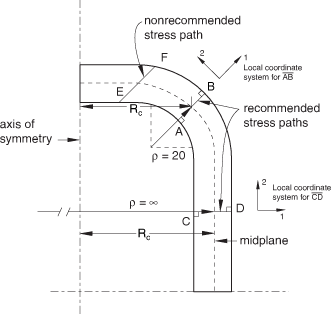Computing the stress components | ||||||
|
| |||||
ProductsAbaqus/CAE
Stress values are extracted at regular intervals along the defined section, and integration is performed numerically using the extracted stress values. Membrane, bending, and peak stress values are computed. These stresses are defined as follows:
- Membrane stress
The constant portion of the normal stress such that a pure moment acts on a plane after the membrane stress is subtracted from the total stress.
- Bending stress
The variable portion of the normal stress equal to the equivalent linear stress or, where no peak stresses exist, equal to the total stress minus the membrane stress.
- Peak stress
The portion of the normal stress that exists after the membrane and bending stresses are subtracted from the total stress.
For the best results, the endpoints of the section should be chosen so that the section is normal to the interior and exterior surfaces of the model. This orientation minimizes problems with shear stresses since they will be approximately zero at the ends of the line (Kroenke, 1973).
Three-dimensional structures
The membrane values of the stress components are computed using the following equation:
where
is the membrane value of stress,
t is the thickness of the section,
is the stress along the path, and
x is the coordinate along the path.
The linear bending values of the stress components are computed using the following equations:
where and are the bending values of the stress at point A and point B (the endpoints of the section; see Figure 1).

The integration is performed numerically. Assuming the path between point A and point B is divided uniformly into n intervals, the integrals are evaluated as follows:
and
where is the stress at point j along the path.
![]()
Axisymmetric structures
The derivation of the above equations is similar for the axisymmetric case, except for the fact that the neutral axis is shifted radially outward. Separate expressions are obtained for the stresses in the thickness, meridional, and hoop directions. In Abaqus/CAE these are represented as local directions 1, 2, and 3, respectively (see Figure 2).

Meridional stress
The meridional stresses are computed using the following relations. The meridional force per unit circumferential length is
where
is the stress in the meridional direction,
R is the radius of the point being integrated, and
is the mean circumferential radius.
The meridional membrane stress is obtained by dividing through the thickness:
The numerical scheme used to compute the meridional membrane stress is
where
is the meridional stress component at point j along the path and
is the radius at point j along the path.
To compute the meridional bending stresses, we first need to compute the distance from the center surface to the neutral surface for meridional bending. That distance, , is equal to
where is the angle between the thickness direction and the radial direction.
The meridional bending moment per unit circumferential length is defined as
and the moment of inertia for meridional bending is given by
Hence, the meridional bending stresses at the endpoints A and B are obtained with
The numerical scheme used to compute the meridional bending moment is
Hoop stress
The hoop membrane stress is obtained with
where
is the hoop stress and
is the radius of curvature of the midsurface of the section in the meridional plane.
The hoop bending stresses at the endpoints are obtained using the relations
where
is the distance from the center surface to the neutral surface for hoop bending,
is the hoop bending moment per unit meridional length, and
is the moment of inertia for circumferential bending.
The numerical scheme to compute the circumferential membrane stress is
and the bending moment is computed with the summation
Thickness stress
The thickness stress does not transfer any forces or moments. Typically, the stress arises due to applied external pressures and thermal expansion effects, and there is no obvious preferred method for determining membrane and bending stresses. Hence, we choose the thickness membrane stress as the average thickness stress:
We choose the thickness bending stress such that the sum of the thickness membrane and bending stresses at the endpoints A and B is equal to the total stress at these points:
and interpolate the bending stress linearly between these values. This is a reasonable assumption, since the thickness surface stresses are determined by the applied pressure and should not have a strong peak stress contribution.
Shear stress
The membrane shear stress in the meridional plane is computed in the same way as the meridional membrane stress:
where is the shear stress along the path.
The shear stress distribution is assumed to be parabolic and equal to zero at the ends. Hence, the bending shear stresses are set to 0.0. The numerical scheme used to compute the membrane shear stress is: